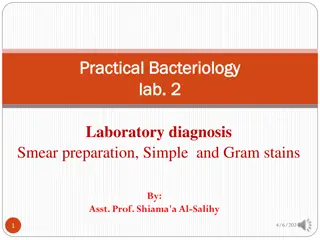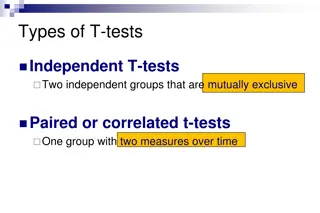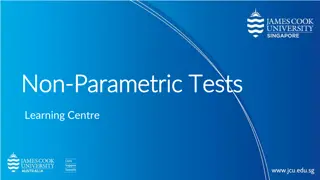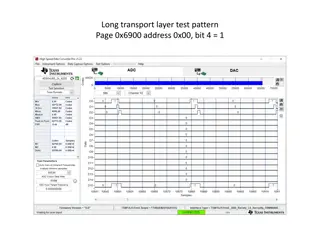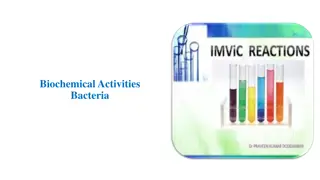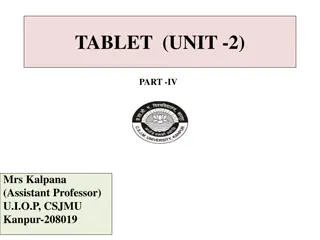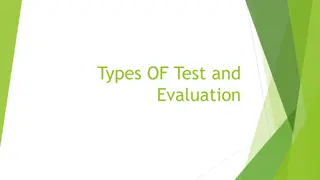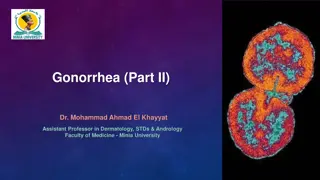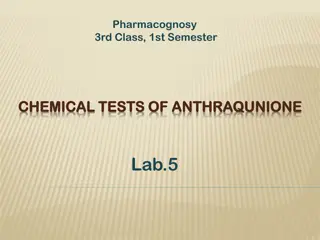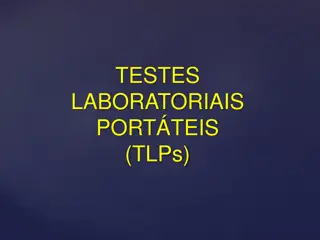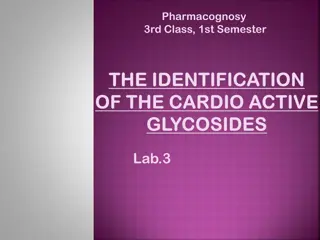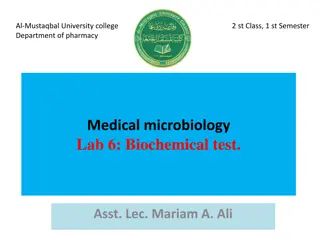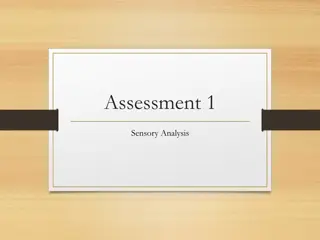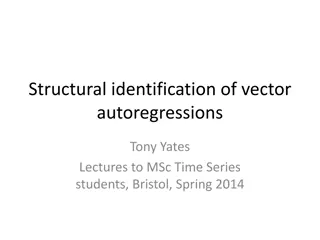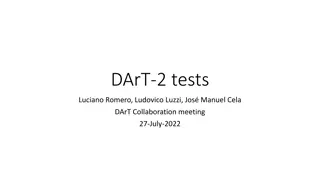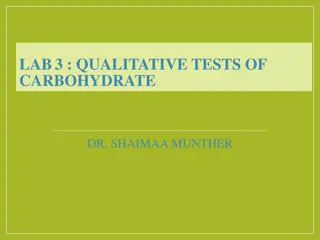Construction of an Achievement Test
Learn about achievement tests, standardized tests, oral tests, essay tests, and more for student evaluation. This guide discusses various types of tests and their purposes in assessing student learning. Enhance your understanding of educational assessment methods with this comprehensive resource
0 views • 29 slides
Identification of Cardioactive Glycosides in Pharmacognosy Lab Experiments
In this Pharmacognosy lab session, students learn about the identification of cardioactive glycosides through chemical tests like Baljets Test and Keller-Killians Test. These tests involve specific procedures using reagents like picric acid, sodium hydroxide, glacial acetic acid, ferric chloride, an
0 views • 11 slides
Practical Bacteriology Laboratory Diagnosis and Sample Collection
This practical guide focuses on laboratory diagnosis steps in bacteriology, covering specimen collection, microscopic examination, culture tests, biochemical tests, serological tests, and molecular tests. Learn about various sample collection methods for urine, stool, swabs, sputum, pus, CSF, and mo
3 views • 23 slides
Understanding Bial's & Seliwanoff's Tests in Clinical Chemistry
Bial's and Seliwanoff's tests are chemical tests used to detect the presence of pentoses in a sample, distinguishing them from hexoses. These tests involve specific reactions with reagents to produce distinct color changes based on the type of sugar present. The Bial's test, particularly sensitive t
0 views • 17 slides
M O N I T O R T R A I N I N G F L O R I D A S TAT E W I D E A S S E S S M E N T S
Monitoring and Assessment Overview for Florida's Statewide Assessments (ARDA) in Spring 2023 encompass a range of standardized tests administered across districts to ensure test integrity and validity. Tests include FSA, FAST, NGSSS, and B.E.S.T., covering ELA, Math, and Science for various grade le
0 views • 30 slides
Understanding SOLs: Information for Parents at Lees Corner - Spring 2022
SOLs, or Standards of Learning tests, are standardized assessments in Virginia to measure student mastery of grade-level content. These tests are essential for graduation requirements, school effectiveness evaluation, and meeting both federal and state testing mandates. Students are tested on variou
1 views • 12 slides
Understanding Fibres: Types, Classification, and Identification
Fibres are vital materials used in various industries. They are classified into natural, artificial, and synthetic categories based on their source. Differentiation of fibres occurs in pericyclic, phloem, and xylem regions. Identification involves microscopical examination, physical tests, and chemi
1 views • 30 slides
Comprehensive Overview of Pulmonary Function Tests (PFTs)
Pulmonary Function Tests (PFTs) are vital for assessing pulmonary gas exchange through ventilation, diffusion, and lung perfusion. These tests include measurements of lung volume, airway patency, gas exchange efficacy, and pulmonary blood flow. PFTs offer benefits in diagnosing dyspnea, monitoring d
0 views • 14 slides
Understanding Verbal and Non-Verbal Tests
Verbal and non-verbal tests serve different purposes in assessing intelligence and skills. Non-verbal tests utilize images and diagrams to measure reasoning abilities without requiring reading or writing. Verbal tests, on the other hand, assess language-based skills through reading, writing, or oral
0 views • 14 slides
Understanding Renal Function Tests and Kidney Health
Renal function tests are essential for diagnosing and monitoring kidney health. These tests assess functions like glomerular filtration, tubular reabsorption, and endocrine functions of the kidneys. Common indicators include serum urea, creatinine levels, and more. It's crucial to evaluate renal fun
0 views • 34 slides
Understanding Different Types of T-Tests in Psychological Research
This article provides an overview of different types of t-tests used in psychological research, including independent t-tests for comparing two groups, paired or correlated t-tests for within-group comparisons, and the assumptions behind conducting these tests. It also includes examples of when to u
1 views • 7 slides
Identification and Assay of Ammonium Chloride: Experiment Insights
Explore the identification and assay process of Ammonium Chloride (NH4Cl), a weak inorganic acid commonly used in various applications. Discover its chemical properties, synthesis, reactivity, identification tests, and details of a titration process using NaOH and phenolphthalein as indicators.
0 views • 16 slides
Understanding Non-Parametric Tests and Their Applications
Non-parametric tests serve as valuable alternatives to parametric tests when data do not meet specific criteria. This article explores the concept of non-parametric tests, types of non-parametric tests, and provides insights on conducting the Mann-Whitney U Test using SPSS for practical research app
4 views • 32 slides
Long Transport Layer Test Patterns for Data Evaluation
Explore various test patterns for data evaluation purposes including long transport layer tests, ADC data reverse order tests, 12-0ctet RPAT tests, and D21.5 tests. These patterns involve specific addresses and data configurations that need to be established before usage with TSW14J57EVM. Each patte
0 views • 4 slides
Understanding Biochemical Tests for Bacterial Identification
Explore the importance of biochemical tests like Triple Sugar Iron Agar and IMViC in identifying enteric bacteria. Learn about indole production and the Methyl Red test, essential in distinguishing bacterial species based on their metabolic activities. Discover how these tests aid in diagnosing food
2 views • 17 slides
Quality Control Tests for Tablet Production
Quality control tests play a crucial role in ensuring the safety and efficacy of tablet products. This article discusses various parameters like general appearance, size, shape, unique identification markings, organoleptic properties, hardness, friability, weight variation, and content uniformity th
1 views • 11 slides
Understanding Types of Test and Evaluation in Education
Explore the various types of tests used in education, including pre-tests, mastery tests, and diagnostic tests. Learn about different mediums for testing, such as oral, written, and performance tests. Discover the role of examinees in essay-type and objective-type tests. Lastly, delve into different
1 views • 13 slides
Understanding Achievement and Aptitude Tests in Education
Explore the differences between achievement and aptitude tests, such as how they measure abilities and knowledge. Learn about teacher-made tests, standardized tests, low-stake, and high-stake tests. Discover the importance of achievement tests in evaluating present proficiency and aptitude tests in
1 views • 16 slides
Gonorrhea Diagnostic Methods and Tests Overview
Dr. Mohammad Ahmad El Khayyat, an Assistant Professor in Dermatology, STDs, and Andrology, details the diagnostic methods and tests for gonorrhea. Various tests including Gram stain, culture, antigen detection tests, and nucleic acid amplification tests are discussed, highlighting sensitivity and sp
1 views • 30 slides
Chemical Tests of Anthraquinone in Aloe Vera Extract
This laboratory experiment focuses on conducting chemical tests to identify anthraquinone glycosides in Aloe vera extract. The tests include Schoneten's reaction (Borax test) and Bromine test for aloin, providing specific reactions for the presence of these compounds. Additionally, special reagents
1 views • 12 slides
Understanding Achievement Tests in Education
Achievement tests play a crucial role in assessing student progress in schools, aiding curriculum planning, and evaluating teaching programs. These tests measure individual accomplishments after a period of learning, helping to determine the effectiveness of instruction. Characteristics such as reli
2 views • 30 slides
Integrated Language Tests and Assessments Overview
This content delves into integrated language tests and assessments, exploring the differences between separate skills tests and integrated tests. It covers the rationale behind integrating language skills, examples of integrated skills tests, as well as shortcomings to avoid in test design. Key aspe
1 views • 35 slides
Understanding Portable Laboratory Tests (TLPs)
Portable laboratory tests (TLPs) bring convenience but must not compromise quality and safety. Errors in the TLP process can impact patient safety, and the simplistic notion of error-proof TLPs is misguided. Quality and safety standards for TLPs should not be shifted to society, and performing tests
0 views • 40 slides
Quality Control Tests for Pharmaceutical Packaging Materials
This article discusses quality control tests for pharmaceutical packaging materials focusing on glass containers. The tests include chemical resistant tests such as powdered glass test and water attack test, as well as hydrolytic resistance tests. Detailed procedures for each test are outlined along
3 views • 18 slides
Understanding Every Student Succeeds Act (ESSA) Testing Guidelines for Families
ESSA requires states to set challenging academic standards and conduct annual tests aligned with those standards. Parents have a say in choosing the standards and tests for their children. Flexibilities exist for eighth-grade math tests, high school tests, and innovative testing approaches, offering
2 views • 25 slides
Identification of Cardioactive Glycosides Through Chemical Tests
The laboratory experiments focus on identifying cardioactive glycosides through chemical tests like Baljets Test and Keller-Killians Test. These tests involve reactions with specific reagents to observe color changes and layer formations, helping in the identification of different parts of the glyco
2 views • 11 slides
Understanding Child and Dependent Care Expenses Credit
The Child and Dependent Care Expenses Credit allows taxpayers to reduce their tax liability by a portion of expenses incurred for caring for qualifying persons. Qualifying persons include children under 13, incapacitated spouses or dependents, and certain criteria must be met to claim the credit. Th
7 views • 10 slides
Understanding LRIT System for Ship Identification and Tracking
LRIT (Long Range Identification and Tracking) system enables global identification and tracking of ships for security purposes. Ships equipped with LRIT system can autonomously transmit ship data to authorized authorities. LRIT system is mandatory for certain types of vessels as per SOLAS convention
0 views • 12 slides
Identification of Cardioactive Glycosides in Pharmacognosy Lab Experiments
The lab experiments focus on identifying cardioactive glycosides using chemical tests like Baljets Test and Keller-Killians Test, along with the identification of sterol glycosides through Raymmonds and Kedds reactions. These tests involve specific procedures with different reagents to observe color
0 views • 11 slides
Mineral Identification Challenge for 7th Grade Science Students
Engage in a Mineral Identification Challenge where 7th-grade students will explore various minerals using color, streak, luster, transparency, texture, composition, density, crystal shape, cleavage/fracture, hardness, and special properties. Students will rotate through different stations, perform t
0 views • 11 slides
Microbiology Biochemical Tests for Bacterial Identification
Learn about important biochemical tests used in medical microbiology, including the Coagulase test for Staphylococcus aureus, the Catalase test for enzyme detection, and the Oxidase test for electron transport chain identification. Detailed methods and result interpretations are provided for each te
0 views • 17 slides
Qualitative Tests of Proteins & Amino Acids: Overview and Analysis
In this lab, you will delve into the qualitative tests for proteins and amino acids, understanding their structures, classifications, and importance in food and human nutrition. The tests include solubility tests and identification tests for both amino acids and proteins, revealing their presence an
0 views • 13 slides
Qualitative Tests of Proteins & Amino Acids - Lab Analysis Overview
This lab analysis covers qualitative tests for proteins and amino acids, including solubility tests and identification tests for amino acids and proteins. Specific tests like Ninhydrin test for -L amino acids, Xanthoproteic test for aromatic amino acids, and lead sulfite test for sulfhydryl group de
0 views • 13 slides
Sensory Analysis Tests in Food Evaluation
Explore different sensory analysis tests used in food evaluation, including paired comparison tests for sweetness, quantitative descriptive analysis for taste attributes, and affective tests like hedonic tests. Understand the purpose and methodology of each test to enhance product development and qu
0 views • 12 slides
Fine-Grained Language Identification Using Multilingual CapsNet Model
This study explores fine-grained language identification through a multilingual CapsNet model, addressing challenges such as short audio snippets, multiple languages, noise, limited training data, and non-class identification. The dataset includes various languages like Arabic, Bengali, Chinese, Eng
0 views • 36 slides
Understanding Structural Identification in Vector Autoregressions
Explore the algebra of identification problems in VARs, including Cholesky factorization, timing restrictions, long-run impact restrictions, sign restrictions, and identification through heteroskedasticity. Discover why structural identification is crucial for policy design, economic modeling, and u
0 views • 63 slides
DArT-2 Tests and Experiments Overview
The DArT-2 tests involve twin experiments - DArT-2 and DArT-Test, focusing on ensuring the performance of DArT-2 in studying underground argon. Various tests like electronic tests of the PDM and vacuum tests are conducted to guarantee proper operation. Challenges with vacuum sealing and solutions li
0 views • 8 slides
Understanding the Differences Between Objective and Projective Tests
Objective tests aim to maximize objectivity by providing structured response options, while projective tests delve into hidden emotions and conflicts through ambiguous stimuli. Pros of objective tests include standardization and reliability, but projective tests offer unique insights based on indivi
0 views • 10 slides
Understanding Unit Testing in Software Engineering
Concept Software is a discipline comprising various code pieces. Testing these codes together is complex but vital in Software Engineering. The process includes early testing like unit tests, pairwise/multiple component testing, module testing, integration testing, user tests, alpha tests, beta test
0 views • 6 slides
Qualitative Tests of Carbohydrates in Biochemistry Lab
The lab features qualitative tests for identifying different types of carbohydrates such as pentose and hexose monosaccharides. Tests include Bial's test to distinguish between sugar types, Seliwanoff's test for aldoses and ketoses differentiation, and Iodine test for polysaccharide detection. Each
0 views • 9 slides


